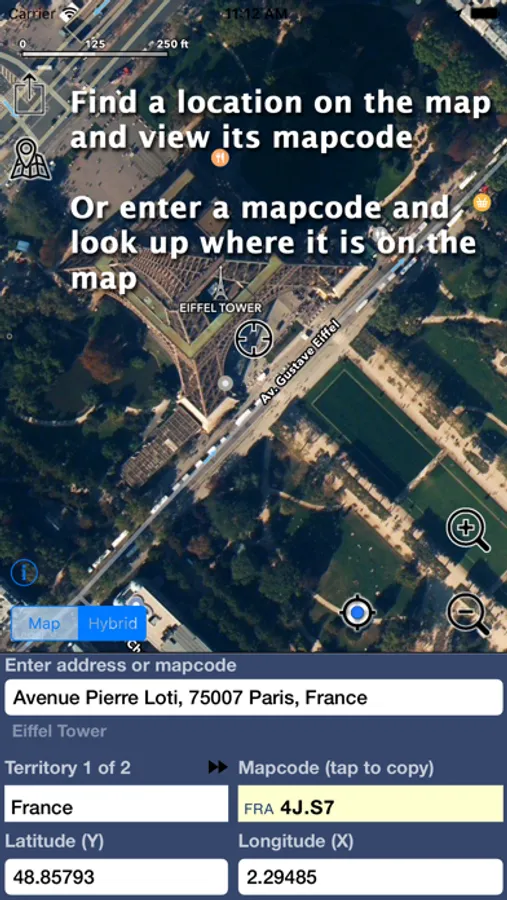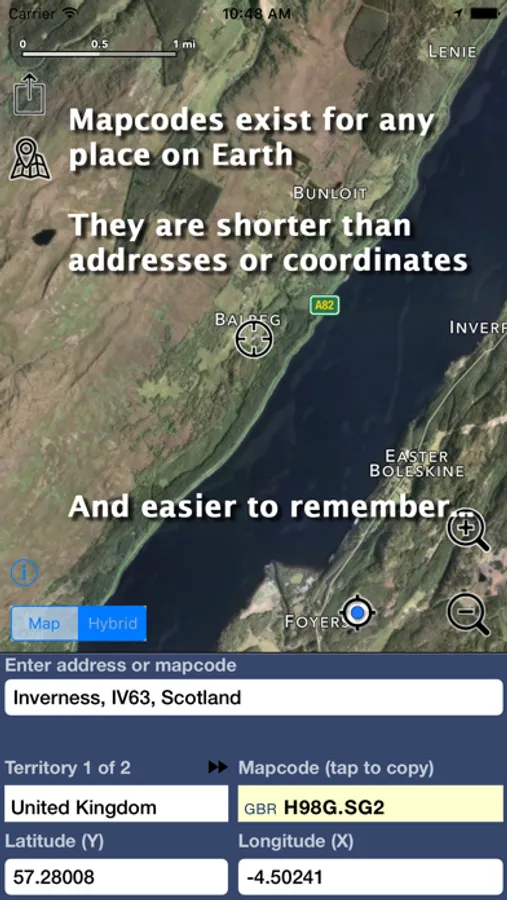Mapcode Finder
Rijn Buve
Free
About Mapcode Finder
This app provides a short address for ANY location on Earth. Much like a postal code, except its a world-wide postal code.
What are mapcodes?
Mapcodes are a free and open way to make location on Earth addressable by a short code even if it has no "official" address. For instance, with nothing but your mapcode, a navigation system will bring you to within meters of your front door.
This app allows you to get mapcodes for any location on Earth by finding the location on the map, entering its coordinates, or entering its address (if that exists). And, obviously, if you have a mapcode, this app will you show where the location is and allow you to get a route to it (using the Maps app).
Mapcodes were designed to be short and easy to recognize, remember and communicate. Shorter than a regular address and simpler than latitude and longitude coordinates.
Regular mapcodes are precise to a few meters, which is good enough for everyday use, but they can be extended to almost arbitrary precision.
Mapcodes are supported by major map makers, such as HERE and TomTom. For example, the HERE and TomTom navigation apps (also in this AppStore) and millions of satnav devices recognize mapcodes out-of-the box. Just type it in as if it were your address.
Who uses mapcodes? Here are some examples of using mapcodes in real life.
Emergency services need to quickly reach the strangest places. Not only will a Mapcode get an ambulance to within meters of its target, no matter where, but the short mapcodes can also be communicated clearly even over bad connections (for example in Eastern Cape and South Africa).
Many countries are currently considering mapcodes as a candidate for their national postcode. Most countries today only have "zone" codes, where thousands of dwellings share the same code. South Africa was the first to introduce mapcodes to officially support informal dwellings (such as slum dwellings).
In countries without an effective addressing system, utility services can not readily come to aid of households or businesses when they are faced with power cuts or water leakages. In Kenya, Uganda and Nigeria, electricity and water meters bear mapcodes which aren't just their unique identifier, but acts as the address of that particular house or business.
Archeological and botanical finds are (of course) registered very precisely. Many errors are made, however, both in writing down and in copying the unwieldy latitudes and longitudes. Mapcodes are now used to put a human face on coordinates by the Naturalis Biodiversity Center.
Land or building ownership is a relevant and complicated, but vastly under-organized issue in many countries. Several land registry offices are looking into easily and unique identifying parcels of land by their central mapcode whilst others (South Africa, India, USA) have implemented mapcode down to a 1m2 accuracy for urban planning and asset management.
Contact the Mapcode Foundation for more information on mapcodes or for questions or feedback on this app. You can reach us at http://mapcode.com and info@mapcode.com.
What are mapcodes?
Mapcodes are a free and open way to make location on Earth addressable by a short code even if it has no "official" address. For instance, with nothing but your mapcode, a navigation system will bring you to within meters of your front door.
This app allows you to get mapcodes for any location on Earth by finding the location on the map, entering its coordinates, or entering its address (if that exists). And, obviously, if you have a mapcode, this app will you show where the location is and allow you to get a route to it (using the Maps app).
Mapcodes were designed to be short and easy to recognize, remember and communicate. Shorter than a regular address and simpler than latitude and longitude coordinates.
Regular mapcodes are precise to a few meters, which is good enough for everyday use, but they can be extended to almost arbitrary precision.
Mapcodes are supported by major map makers, such as HERE and TomTom. For example, the HERE and TomTom navigation apps (also in this AppStore) and millions of satnav devices recognize mapcodes out-of-the box. Just type it in as if it were your address.
Who uses mapcodes? Here are some examples of using mapcodes in real life.
Emergency services need to quickly reach the strangest places. Not only will a Mapcode get an ambulance to within meters of its target, no matter where, but the short mapcodes can also be communicated clearly even over bad connections (for example in Eastern Cape and South Africa).
Many countries are currently considering mapcodes as a candidate for their national postcode. Most countries today only have "zone" codes, where thousands of dwellings share the same code. South Africa was the first to introduce mapcodes to officially support informal dwellings (such as slum dwellings).
In countries without an effective addressing system, utility services can not readily come to aid of households or businesses when they are faced with power cuts or water leakages. In Kenya, Uganda and Nigeria, electricity and water meters bear mapcodes which aren't just their unique identifier, but acts as the address of that particular house or business.
Archeological and botanical finds are (of course) registered very precisely. Many errors are made, however, both in writing down and in copying the unwieldy latitudes and longitudes. Mapcodes are now used to put a human face on coordinates by the Naturalis Biodiversity Center.
Land or building ownership is a relevant and complicated, but vastly under-organized issue in many countries. Several land registry offices are looking into easily and unique identifying parcels of land by their central mapcode whilst others (South Africa, India, USA) have implemented mapcode down to a 1m2 accuracy for urban planning and asset management.
Contact the Mapcode Foundation for more information on mapcodes or for questions or feedback on this app. You can reach us at http://mapcode.com and info@mapcode.com.
Mapcode Finder Screenshots
Tap to Rate:




